Using a Public Preference Questionnaire and Eye Movement Heat Maps to Identify the Visual Quality of Rural Landscapes in Southwestern Guizhou, China
Abstract
:1. Introduction
1.1. Research on Rural Landscape Characteristics
1.2. Literature Review
1.2.1. Landscape Characteristics and Their Evaluation
1.2.2. Landscape Perception and Visual Quality
- (1)
- The classification and type identification of rural landscape features in Southwest China;
- (2)
- Determining the public’s preference for visual quality based on the rural landscape characteristics of Southwest China;
- (3)
- Determining the landscape characteristics and population characteristics that affect rural landscape preferences in Southwest China.
2. Materials and Methods
2.1. Study Area
2.2. Study Methods
2.3. The First Step
2.4. The Second Step
3. Results
3.1. Demographic Description
3.2. Photo Survey
3.3. The Impact of Heat Maps and Landscape Features on Visual Quality Assessment
3.4. Related Factors That Affect Visual Quality
4. Discussion
4.1. The Impact of Landscape Elements on the Visual Quality of Rural Landscapes
4.2. The Impact of Visual Characteristics on the Visual Quality of Rural Landscapes
4.3. The Impact of Subjects’ Demographic Characteristics on Preferences
5. Conclusions
Author Contributions
Funding
Data Availability Statement
Acknowledgments
Conflicts of Interest
Appendix A

| Photos | ||
|---|---|---|
| Active Landscape Visual Quality |  |  |
| Mean = 0.87 (LC-6-3) | Mean = 0.83 (LC-1-2) | |
 |  | |
| Mean = 0.79 (LC-9-4) | Mean = 0.68 (LC-3-2) | |
 | 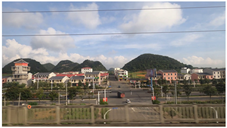 | |
| Mean = 0.66 (LC-3-3) | Mean = 0.64 (LC-3-5) | |
| Passive Landscape Visual Quality |  |  |
| Mean = −0.64 (LC-7-2) | Mean = −0.57 (LC-8-4) | |
 |  | |
| Mean = −0.48 (LC-4-3) | Mean = −0.39 (LC-4-4) | |
 |  | |
| Mean = −0.33 (LC-4-5) | Mean = −0.28 (LC-12-2) | |
| Group | Landscape Character | Code | Individual Mean Value | Average Value | |
|---|---|---|---|---|---|
| Active Landscape Visual Quality | 6 | Field and landform landscape | LC-6-1 | 0.57 | 0.606 |
| LC-6-2 | 0.61 | ||||
| LC-6-3 | 0.87 | ||||
| LC-6-4 | 0.45 | ||||
| LC-6-5 | 0.53 | ||||
| 1 | Field landscape surrounded by mountains | LC-1-1 | 0.18 | 0.514 | |
| LC-1-2 | 0.83 | ||||
| LC-1-3 | 0.673 | ||||
| LC-1-4 | 0.42 | ||||
| LC-1-5 | 0.51 | ||||
| 9 | Plateau landform natural landscape | LC-9-1 | 0.36 | 0.486 | |
| LC-9-2 | 0.25 | ||||
| LC-9-3 | 0.48 | ||||
| LC-9-4 | 0.79 | ||||
| LC-9-5 | 0.55 | ||||
| 3 | Plateau landforms and roadside strip settlement buildings | LC-3-1 | 0.22 | 0.438 | |
| LC-3-2 | 0.68 | ||||
| LC-3-3 | 0.66 | ||||
| LC-3-4 | −0.01 | ||||
| LC-3-5 | 0.64 | ||||
| 2 | Natural landforms, fields, and settlement landscapes | LC-2-1 | 0.18 | 0.26 | |
| LC-2-2 | 0.24 | ||||
| LC-2-3 | 0.33 | ||||
| LC-2-4 | 0.15 | ||||
| LC-2-5 | 0.38 | ||||
| 5 | Settlement and landscape | LC-5-1 | 0.08 | 0.086 | |
| LC-5-2 | 0.12 | ||||
| LC-5-3 | −0.01 | ||||
| LC-5-4 | −0.02 | ||||
| LC-5-5 | 0.26 | ||||
| Moderate Visual Quality (M = 0) | |||||
| Passive Landscape Visual Quality | 7 | Plateau landform settlements and winding rural roads | LC-7-1 | −0.26 | −0.272 |
| LC-7-2 | −0.64 | ||||
| LC-7-3 | −0.18 | ||||
| LC-7-4 | −0.03 | ||||
| LC-7-5 | −0.25 | ||||
| 8 | Viaduct connecting mountains | LC-8-1 | −0.21 | −0.244 | |
| LC-8-2 | −0.15 | ||||
| LC-8-3 | −0.11 | ||||
| LC-8-4 | −0.57 | ||||
| LC-8-5 | −0.18 | ||||
| 4 | Plateau landforms and scattered settlement buildings | LC-4-1 | −0.05 | −0.242 | |
| LC-4-2 | 0.04 | ||||
| LC-4-3 | −0.48 | ||||
| LC-4-4 | −0.39 | ||||
| LC-4-5 | −0.33 | ||||
| 12 | Field landscape | LC-12-1 | −0.11 | −0.15 | |
| LC-12-2 | −0.28 | ||||
| LC-12-3 | −0.18 | ||||
| LC-12-4 | −0.06 | ||||
| LC-12-5 | −0.12 | ||||
| 10 | Field and settlement landscape | LC-10-1 | 0.01 | −0.05 | |
| LC-10-2 | −0.08 | ||||
| LC-10-3 | −0.02 | ||||
| LC-10-4 | −0.05 | ||||
| LC-10-5 | −0.11 | ||||
| 11 | Settlement and plant landscape | LC-11-1 | −0.01 | −0.028 | |
| LC-11-2 | −0.04 | ||||
| LC-11-3 | −0.02 | ||||
| LC-11-4 | −0.03 | ||||
| LC-11-5 | −0.04 | ||||
| Photos Collected | Eye Tracking Analysis (Heat Map) | |
|---|---|---|
| Active Landscape Visual Quality |  |  |
| 1. Group (Mean), Landscape Character | 6 (LC-6-3, Mean = 0.87), Fields and natural landscapes | |
 | 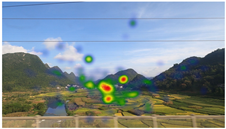 | |
| 2. Group (Mean), Landscape Character | 1 (LC-1-2, Mean = 0.83), Field landscape surrounded by mountains | |
 |  | |
| 3. Group (Mean), Landscape Character | 9 (LC-9-4, Mean = 0.79), Plateau landform natural landscape | |
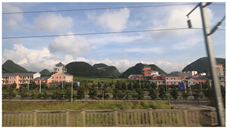 |  | |
| 4. Group (Mean), Landscape Character | 3 (LC-3-2, Mean = 0.68), Plateau landforms and roadside strip settlement buildings | |
 |  | |
| 5. Group (Mean), Landscape Character | 3 (LC-3-3, Mean = 0.66), Plateau landforms and roadside strip settlement buildings | |
 |  | |
| 6. Group (Mean), Landscape Character | 3 (LC-3-5, Mean = 0.64), Plateau landforms and roadside strip settlement buildings | |
| Moderate Visual Quality (M = 0) | ||
| Passive Landscape Visual Quality |  |  |
| 1. Group (Mean), Landscape Character | 7 (LC-7-2, Mean = −0.64), Plateau landform settlements and winding rural roads | |
 | 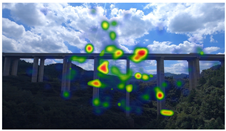 | |
| 2. Group (Mean), Landscape Character | 8 (LC-8-4, Mean = −0.57), Viaduct connecting mountains | |
 |  | |
| 3. Group (Mean), Landscape Character | 4 (LC-4-3, Mean = −0.48), Plateau landforms and scattered settlement buildings | |
 |  | |
| 4. Group (Mean), Landscape Character | 4 (LC-4-4, Mean = −0.39), Plateau landforms and scattered settlement buildings | |
 |  | |
| 5. Group (Mean), Landscape Character | 4 (LC-4-5, Mean = −0.33), Plateau landforms and scattered settlement buildings | |
 |  | |
| 6. Group (Mean), Landscape Character | 12 (LC-12-2, Mean = −0.28), Field landscape | |
References
- Lu, B.; Chen, W. A preliminary study on rural landscape gardens in China. Urban Plan. Foumm. 2000, 6, 66–68, 80. [Google Scholar]
- Brumann, C.; Gfeller, A.É. Cultural landscapes and the UNESCO World Heritage List: Perpetuating European dominance. Int. J. Herit. Stud. 2022, 28, 147–162. [Google Scholar] [CrossRef]
- UNESCO. Operational Guidelines for the Implementation of the World Heritage Convention; WHC 08/1; UNESCO: Paris, France, 2008. [Google Scholar]
- Jane, L.; Han, F. Rural landscapes. Chin. Landsc. Archit. 2012, 28, 19–21. [Google Scholar]
- Wang, Y.; Chen, Z.; Cheng, Y. The Representation System of Rural Landscape Character and Personality in the New Era. Landsc. Archit. 2021, 28, 10713. [Google Scholar]
- Zakariya, K.; Ibrahim, P.H.; Abdul Wahab, N.A. Conceptual Framework of Rural Landscape Character Assessment to Guide Tourism Development in Rural Areas. J. Constr. Dev. Ctries. 2019, 24, 85–99. [Google Scholar] [CrossRef]
- Arriaza, M.; Cañas-Ortega, J.; Cañas-Madueño, J.; Ruiz-Aviles, P. Assessing the visual quality of rural landscapes. Landsc. Urban Plan. 2004, 69, 115–125. [Google Scholar] [CrossRef]
- Yun, W.-J.; Yu, Z.-R. Ecological landscaping strategy of rural land consolidation in China. Trans. Chin. Soc. Agric. Eng. 2011, 27, 1–6. [Google Scholar]
- Gu, X.-K.; Chen, B.-M. Method and application of landscape ecological evaluation of land consolidation: A case of land consolidation project in Jianghan Plain. China Land Sci. 2008, 22, 58–62. [Google Scholar]
- Chen, Z.; Xu, F. Driving factors and mechanism of rural tourist destination development: Evidence from Changsha city. Econ. Geogr. 2019, 39, 231–239. [Google Scholar]
- Swanwick, C. Landscape character assessment. In Guidance for England and Scotland; Countryside Agency, Scottish Natural Heritage: Edinburgh, UK, 2002. [Google Scholar]
- Mundher, R.; Bakar, S.A.; Al-Helli, M.; Gao, H.; Al-Sharaa, A.; Yusof, M.T.; Maulan, S.; Aziz, A. Visual Aesthetic Quality Assessment of Urban Forests: A Conceptual Framework. Urban Sci. 2022, 6, 79. [Google Scholar] [CrossRef]
- Golobič, M.; Penko Seidl, N.; Bevk, T.; Pipan, T.; Krošelj, M.; Kostanjšek, B.; Ažman, T.; Hudoklin, J.; Simič, S.; Gritli, L. Redevelopment and Digitisation of the Regional Distribution of Landscape Types and Outstanding Landscapes in Slovenia: First Interim Report; Biotechnical Faculty, Department of Landscape Architecture: Ljubljana, Slovenia, 2022. [Google Scholar]
- Marušič, I.; Ogrin, D.; Jančič, M. Regionalna Razdelitev Krajinskih Tipov v Sloveniji. Metodološke Osnove; Ministry of Environment and Spatial Planning, RSS Office for Spatial Planning; Department of Landscape Architecture, Biotechnical Faculty, University of Ljubljana: Ljubljana, Slovenia, 1998; p. 120. [Google Scholar]
- Kuan, A. The modern social conception of Slovene space. Geogr. Zb. 1997, 37, 106–167. [Google Scholar]
- Wascher, D.M. European Landscape Character Areas—Typologies, Cartography and Indicators for the Assessment of Sustainable Landscapes. In Landscape Europe; Final Project Report as Deliverable from the EU’s Accompanying Measure Project European Landscape Character Assessment Initiative (ELCAI), Funded under the 5th Framework Programme on Energy, Environment and Sustainable Development (4.2.2); Wageningen Environmental Research: Wageningen, The Netherlands, 2005; pp. 36–40. [Google Scholar]
- Gobster, P.H.; Nassauer, J.I.; Daniel, T.C.; Fry, G. The shared landscape: What does aesthetics have to do with ecology? Landsc. Ecol. 2007, 22, 959–972. [Google Scholar] [CrossRef]
- Mundher, R.; Bakar, S.A.; Maulan, S.; Yusof, M.T.; Al-Sharaa, A.; Aziz, A.; Gao, H. Aesthetic Quality Assessment of Landscapes as a Model for Urban Forest Areas: A Systematic Literature Review. Forests 2022, 13, 991. [Google Scholar] [CrossRef]
- Tveit, M.; Ode, Å.; Fry, G. Key concepts in a framework for analysing visual landscape character. Landsc. Res. 2006, 31, 229–255. [Google Scholar] [CrossRef]
- Martín, B.; Ortega, E.; Otero, I.; Arce, R. Landscape character assessment with GIS using map-based indicators and photographs in the relationship between landscape and roads. J. Environ. Manag. 2016, 180, 324–334. [Google Scholar] [CrossRef] [PubMed]
- Fry, G.; Tveit, M.S.; Ode, Å.; Velarde, M.D. The ecology of visual landscapes: Exploring the conceptual common ground of visual and ecological landscape indicators. Ecol. Indic. 2009, 9, 933–947. [Google Scholar] [CrossRef]
- Ozcelik, E.; Karakus, T.; Kursun, E.; Cagiltay, K. An eye-tracking study of how color coding affects multimedia learning. Comput. Educ. 2009, 53, 445–453. [Google Scholar] [CrossRef]
- Wilson, E.O. Biophilia; Harvard University Press: Cambridge, MA, USA, 1984. [Google Scholar]
- Kaymaz, I.C. Landscape perception. In Landscape Planning; Ozyavuz, M., Ed.; IntechOpen: London, UK, 2012; pp. 251–276. [Google Scholar]
- Appleton, J. Landscape evaluation: The theoretical vacuum. Trans. Inst. Br. Geogr. 1975, 66, 120–123. [Google Scholar] [CrossRef]
- Kaplan, R.; Kaplan, S. The Experience of Nature: A Psychological Perspective; Cambridge University Press: New York, NY, USA, 1989. [Google Scholar]
- Kaplan, R.; Kaplan, S.; Ryan, R.L. With People in Mind: Design and Management of Everyday Nature; Island: Washington, DC, USA, 1998. [Google Scholar]
- Van den Berg, A.E.; Jorgensen, A.; Wilson, E.R. Evaluating restoration in urban green spaces: Does setting type make a difference? Landsc. Urban Plan. 2014, 127, 173–181. [Google Scholar] [CrossRef]
- Daniel, T.C. Whither scenic beauty? Visual landscape quality assessment in the 21st century. Landsc. Urban Plan. 2001, 54, 267–281. [Google Scholar] [CrossRef]
- Pals, R.; Steg, L.; Siero, F.W.; van der Zee, K.I. Development of the PRCQ: A measure of perceived restorative characteristics of zoo attractions. J. Environ. Psychol. 2009, 29, 441–449. [Google Scholar] [CrossRef]
- Lee, K.; Son, Y. Exploring landscape perceptions of Bukhansan National Park according to the degree of visitors’ experience. Sustainability 2017, 9, 1306. [Google Scholar] [CrossRef]
- Chiesura, A. The role of urban parks for the sustainable city. Landsc. Urban Plan. 2004, 68, 129–138. [Google Scholar] [CrossRef]
- Liu, Y.S.; Li, Y.H. Revitalize the world’s countryside. Nature 2017, 548, 275–277. [Google Scholar] [CrossRef] [PubMed]
- Wang, X.C.; Dong, X.B.; Liu, H.M.; Wei, H.; Fan, W.; Lu, N.; Xu, Z.; Ren, J.; Xing, K. Linking land use change, ecosystem services and human well-being: A case study of the Manas River Basin of Xinjiang, China. Ecosyst. Serv. 2017, 27, 113–123. [Google Scholar] [CrossRef]
- Liu, Y.; Fang, F.; Li, Y. Key issues of land use in China and implications for policy making. Land Use Policy 2014, 40, 6–12. [Google Scholar] [CrossRef]
- Vaca, R.A.; Rodiles-Hernández, R.; Ochoa-Gaona, S.; Taylor-Aquino, N.E.; Obregon-Viloria, R.; Diaz-Garcia, D.A.; Navarrete-Gutierrez, D.A. Evaluating and supporting conservation action in agricultural landscapes of the Usumacinta River Basin. J. Environ. Manag. 2019, 230, 392–404. [Google Scholar] [CrossRef] [PubMed]
- Liu, B.; Wang, Y. Theoretical base and evaluating indicator system of rural landscape assessment in China. Chin. Landsc. Archit. 2002, 18, 76–79. [Google Scholar]
- Xie, H.; Liu, L.; Li, L. Preliminary study on the correlative problem of the rural landscape planning. Chin. Landsc. Archit. 2003, 19, 39–41. [Google Scholar]
- Arnaiz, S.C.; Schmitz, M.F.; Herrero, J.C.; Gutiérrez-Angonese, J.F.D.C.; Pineda, F.D.; Montes, C. Identifying socio-ecological networks in rural-urban gradients: Diagnosis of a changing cultural landscape. Sci. Total Environ. 2018, 612, 625–635. [Google Scholar] [CrossRef]
- Kirchner, M.; Schmidt, J.; Kindermann, G.; Kulmer, V.; Mitter, H.; Prettenthaler, F.; Rüdisser, J.; Schauppenlehner, T.; Schönhart, M.; Strauss, F.; et al. Ecosystem services and economic development in Austrian agricultural landscapes: The impact of policy and climate change scenarios on tradeoffs and synergies. Ecol. Econ. 2015, 109, 161–174. [Google Scholar] [CrossRef]
- Yang, C.; Tan, S.; Yue, H.; Hu, Y. Influence of Agricultural Structure Transformation on Village Landscape and Residents Satisfaction: A case Study of Jiuling Village in Chongqing. South Archit. 2022, 3, 88–97. [Google Scholar]
- Jia, Z.; Gao, M.; Xu, S.; Lyu, Y.; Feng, J.; Zhou, Z.; Yu, T.; Wu, W. Sociocultural vitality versus regulation policy and tourism development in preservation of traditional rural landscape: A case from Guizhou, China. Int. J. Sustain. Dev. World Ecol. 2021, 28, 179–192. [Google Scholar] [CrossRef]
- Chen, Y.; Wang, X.-D.; Wang, P.-F. Analysis and thought on the rural landscape research in China. Chin. Agric. Sci. Bull. 2011, 27, 297–300. [Google Scholar]
- Schroeder, H.W.; Daniel, T. Preferred features of urban parks and forests. J. Arboric. 1982, 8, 317–322. [Google Scholar] [CrossRef]
- Likert, R. A Technique for the Measurement of Attitudes. Arch. Psychol. 1932, 22, 55. [Google Scholar]
- Zhou, X.; Cen, Q.; Qiu, H. Effects of urban waterfront park landscape elements on visual behavior and public preference: Evidence from eye-tracking experiments. Urban For. Urban Green. 2023, 82, 127889. [Google Scholar] [CrossRef]
- Bishop, I.D.; Rohrmann, B. Subjective responses to simulated and real environments: A comparison. Landsc. Urban Plan. 2003, 65, 261–277. [Google Scholar] [CrossRef]
- Fujisaki, I.; Mohammadi-Aragh, M.J.; Evans, D.L.; Moorhead, R.J.; Irby, D.W.; Roberts, S.D.; Grado, S.C.; Schultz, E.B. Comparing forest assessment based on computer visualization versus videography. Landsc. Urban Plan. 2007, 81, 146–154. [Google Scholar] [CrossRef]
- Lappi, O. Eye Tracking in the Wild: The Good, the Bad and the Ugly. J. Eye Mov. Res. 2015, 8, 1. [Google Scholar] [CrossRef]
- Wartmann, F.M.; Frick, J.; Kienast, F.; Hunziker, M. Factors influencing visual landscape quality perceived by the public. Results from a national survey. Landsc. Urban Plan. 2021, 208, 104024. [Google Scholar] [CrossRef]
- Mundher, R.; Al-Sharaa, A.; Al-Helli, M.; Gao, H.; Abu Bakar, S. Visual Quality Assessment of Historical Street Scenes: A Case Study of the First “Real” Street Established in Baghdad. Heritage 2022, 5, 3680–3704. [Google Scholar] [CrossRef]
- Gao, H.; Abu Bakar, S.; Maulan, S.; Mohd Yusof, M.J.; Mundher, R.; Zakariya, K. Identifying Visual Quality of Rural Road Landscape Character by Using Public Preference and Heatmap Analysis in Sabak Bernam, Malaysia. Land 2023, 12, 1440. [Google Scholar] [CrossRef]
- Hartig, T.; Evans, G.W.; Jamner, L.D.; Davis, D.S.; Gärling, T. Tracking restoration in natural and urban field settings. J. Environ. Psychol. 2003, 23, 109–123. [Google Scholar] [CrossRef]
- Zhang, W.; Ricketts, T.H.; Kremen, C.; Carney, K.; Swinton, S.M. Ecosystem services and dis-services to agriculture. Ecol. Econ. 2007, 64, 253–260. [Google Scholar] [CrossRef]
- Millennium Ecosystem Assessment. Ecosystems and Human Well-Being: Synthesis; Island Press: Washington, DC, USA, 2005. [Google Scholar]
- Wang, R.; Zhao, J.; Liu, Z. Consensus in visual preferences: The effects of aesthetic quality and landscape types. Urban For. Urban Green. 2016, 20, 210–217. [Google Scholar] [CrossRef]
- Lückmann, K.; Lagemann, V.; Menzel, S. Landscape Assessment and Evaluation of Young People: Comparing nature-orientated habitat and engineered habitat preferences. Environ. Behav. 2011, 45, 86–112. [Google Scholar] [CrossRef]
- Zhang, G.; Yang, J.; Wud, G.; Hu, X. Exploring the interactive influence on landscape preference from multiple visual attributes: Openness, richness, order, and depth. Urban For. Urban Green. 2021, 65, 127363. [Google Scholar] [CrossRef]
- Hanyu, K. Visual properties and affective appraisals in residential areas in daylight. J. Environ. Psychol. 2000, 20, 273–284. [Google Scholar] [CrossRef]
- Ode, Å.; Tveit, M.S.; Fry, G. Capturing Landscape Visual Character Using Indicators: Touching Base with Landscape Aesthetic Theory. Landsc. Res. 2008, 33, 89–117. [Google Scholar] [CrossRef]
- Sklenicka, P.; Molnarova, K. Visual Perception of Habitats Adopted for Post-Mining Landscape Rehabilitation. Environ. Manag. 2010, 46, 424–435. [Google Scholar] [CrossRef]
- Walker, A.J.; Ryan, R.L. Place attachment and landscape preservation in rural New England: A Maine case study. Landsc. Urban Plan. 2008, 86, 141–152. [Google Scholar] [CrossRef]
- Dearden, P. Factors influencing landscape preferences: An empirical investigation. Landsc. Plan. 1984, 11, 293–306. [Google Scholar] [CrossRef]
- Balling, J.D.; Falk, J.H. Development of Visual Preference for Natural Environments. Environ. Behav. 1982, 14, 5–28. [Google Scholar] [CrossRef]
- Zube, E.H.; Pitt, D.; Evans, G.W. A lifespan developmental study of landscape assessment. J. Environ. Psychol. 1983, 3, 115–128. [Google Scholar] [CrossRef]
- Howley, P. Landscape aesthetics: Assessing the general publics’ preferences towards rural landscapes. Ecol. Econ. 2011, 72, 161–169. [Google Scholar] [CrossRef]




| Group | Landscape Character | Code | Photo Example |
|---|---|---|---|
| A | Field landscape surrounded by mountains | LC-1-1 |  |
| B | Natural landforms, fields, and settlement landscapes | LC-2-1 | 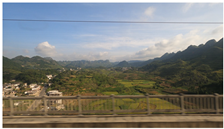 |
| C | Plateau landforms and roadside strip settlement buildings | LC-3-1 |  |
| D | Plateau landforms and scattered settlement buildings | LC-4-1 |  |
| E | Settlement and landscape | LC-5-1 | 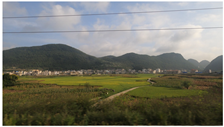 |
| F | Fields and landform landscape | LC-6-1 |  |
| G | Plateau landform settlements and winding rural roads | LC-7-1 |  |
| H | Viaduct connecting mountains | LC-8-1 | 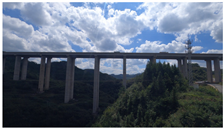 |
| I | Plateau landform natural landscape | LC-9-1 |  |
| J | Field and settlement landscape | LC-10-1 |  |
| K | Settlement and plant landscape | LC-11-1 |  |
| L | Field landscape | LC-12-1 |  |
| Item | Category | Frequency N | Percent % |
|---|---|---|---|
| Place of residence | Urban area | 158 | 64.23% |
| Suburban area | 62 | 25.20% | |
| Rural area | 26 | 10.57% | |
| Gender | Male | 115 | 46.74% |
| Female | 131 | 53.26% | |
| Age | 18 to 25 | 53 | 21.54% |
| 26 to 35 | 125 | 50.81% | |
| 36 to 45 | 37 | 15.04% | |
| 46 to 55 | 19 | 5.69% | |
| Above 55 | 12 | 6.91% | |
| Education level | Junior high school or below | 3 | 1.22% |
| Junior high school | 6 | 2.44% | |
| High school | 35 | 14.23% | |
| Bachelor’s degree | 156 | 63.42% | |
| Master’s degree or higher | 46 | 18.70% | |
| Type of work | Student | 48 | 19.51% |
| Self-employed | 102 | 41.46% | |
| Private sector employee | 73 | 29.67% | |
| Government department employee | 23 | 9.35% | |
| Has previously visited Gui’an metropolitan area | Yes | 43 | 17.48% |
| No | 203 | 82.52% | |
| Resident | Yes | 31 | 12.60% |
| No | 215 | 87.39% | |
| Frequency of visits to rural areas | Less than one a year | 15 | 6.10% |
| 2 times a year | 180 | 73.17% | |
| 3 to 5 times a year | 45 | 18.29% | |
| More than 5 times a year | 6 | 2.43% |
| Active Landscape Visual Quality | Passive Landscape Visual Quality | ||||
|---|---|---|---|---|---|
| No. | Photo Codes | Mean Value | No. | Photo Codes | Mean Value |
| 1 | LC-6-3 | 0.87 | 1 | LC-7-2 | −0.64 |
| 2 | LC-1-2 | 0.83 | 2 | LC-8-4 | −0.57 |
| 3 | LC-9-4 | 0.79 | 3 | LC-4-3 | −0.48 |
| 4 | LC-3-2 | 0.68 | 4 | LC-4-4 | −0.39 |
| 5 | LC-3-3 | 0.66 | 5 | LC-4-5 | −0.33 |
| 6 | LC-3-5 | 0.64 | 6 | LC-12-2 | −0.28 |
| 7 | LC-1-3 | 0.63 | 7 | LC-7-1 | −0.26 |
| 8 | LC-6-2 | 0.61 | 8 | LC-7-5 | −0.25 |
| 9 | LC-6-1 | 0.57 | 9 | LC-8-1 | −0.21 |
| 10 | LC-9-5 | 0.55 | 10 | LC-7-3 | −0.18 |
| 11 | LC-6-5 | 0.53 | 11 | LC-8-5 | −0.18 |
| 12 | LC-1-5 | 0.51 | 12 | LC-12-3 | −0.18 |
| 13 | LC-9-3 | 0.48 | 13 | LC-8-2 | −0.15 |
| 14 | LC-6-4 | 0.45 | 14 | LC-12-5 | −0.12 |
| 15 | LC-1-4 | 0.42 | 15 | LC-8-3 | −0.11 |
| 16 | LC-4-2 | 0.04 | 16 | LC-12-1 | −0.11 |
| 17 | LC-2-5 | 0.38 | 17 | LC-10-5 | −0.11 |
| 18 | LC-9-1 | 0.36 | 18 | LC-10-2 | −0.08 |
| 19 | LC-2-3 | 0.33 | 19 | LC-12-4 | −0.06 |
| 20 | LC-5-5 | 0.26 | 20 | LC-4-1 | −0.05 |
| 21 | LC-9-2 | 0.25 | 21 | LC-10-4 | −0.05 |
| 22 | LC-2-2 | 0.24 | 22 | LC-11-2 | −0.04 |
| 23 | LC-3-1 | 0.22 | 23 | LC-11-5 | −0.04 |
| 24 | LC-1-1 | 0.18 | 24 | LC-7-4 | −0.03 |
| 25 | LC-2-1 | 0.18 | 25 | LC-11-4 | −0.03 |
| 26 | LC-2-4 | 0.15 | 26 | LC-10-3 | −0.02 |
| 27 | LC-5-2 | 0.12 | 27 | LC-11-3 | −0.02 |
| 28 | LC-5-1 | 0.08 | 28 | LC-5-4 | −0.02 |
| 29 | LC-10-1 | 0.01 | 29 | LC-3-4 | −0.01 |
| 30 | LC-5-3 | −0.01 | |||
| 31 | LC-11-1 | −0.01 | |||
| Visual Quality | Valid (N) | N of Items | Reliability Cronbach’s Alpha |
|---|---|---|---|
| Active Landscape Visual Quality | 246 | 30 | 0.956 |
| Passive Landscape Visual Quality | 246 | 30 | 0.948 |
| Total reliability (Cronbach’s Alpha) for 60 photos | 0.962 | ||
| Group | N | Mean | Std. | Skewness | Kurtosis | Kolmogorov–Smirnov Test | |
|---|---|---|---|---|---|---|---|
| Statistic D | p | ||||||
| A | 246 | 0.837 | 0.202 | 0.036 * | −0.229 | 0.218 | 0.000 *** |
| C | 246 | 0.667 | 0.18 | 0.023 * | −0.08 | 0.231 | 0.000 *** |
| F | 246 | 0.869 | 0.223 | 0 *** | −0.314 | 0.183 | 0.000 *** |
| I | 246 | 0.786 | 0.194 | 0.166 | −0.382 | 0.203 | 0.000 *** |
| Active Landscape Visual Quality Group | 246 | 0.79 | 0.15 | −0.078 | −0.438 | 0.099 | 0.000 *** |
| D | 246 | −0.403 | 0.118 | 0.004 ** | −0.117 | 0.328 | 0.000 *** |
| G | 246 | −0.635 | 0.2 | 0.086 | 0.14 | 0.223 | 0.000 *** |
| H | 246 | −0.554 | 0.182 | 0.533 | 1.458 | 0.259 | 0.000 *** |
| L | 246 | −0.272 | 0.109 | 0.042 * | −0.857 | 0.352 | 0.000 *** |
| Passive Landscape Visual Quality Group | 246 | −0.466 | 0.123 | 0.412 | 1.011 | 0.096 | 0.000 *** |
| Group | Variable | N | Mean | Std. | Mean Value Difference | Difference 95% CI | t | df | p |
|---|---|---|---|---|---|---|---|---|---|
| A | Non-visitor | 203 | 0.82 | 0.2 | −0.09 | −0.151~−0.019 | −2.549 | 244 | 0.011 * |
| Visitor | 43 | 0.91 | 0.21 | ||||||
| Total | 246 | 0.84 | 0.2 | ||||||
| C | Non-visitor | 203 | 0.66 | 0.18 | −0.03 | −0.091~0.029 | −1.229 | 244 | 0.22 |
| Visitor | 43 | 0.69 | 0.18 | ||||||
| Total | 246 | 0.67 | 0.18 | ||||||
| F | Non-visitor | 203 | 0.86 | 0.22 | −0.05 | −0.119~0.028 | −1.229 | 244 | 0.22 |
| Visitor | 43 | 0.91 | 0.23 | ||||||
| Total | 246 | 0.87 | 0.22 | ||||||
| I | Non-visitor | 203 | 0.77 | 0.19 | −0.12 | −0.181~−0.056 | −3.729 | 244 | 0.000 *** |
| Visitor | 43 | 0.88 | 0.19 | ||||||
| Total | 246 | 0.79 | 0.19 | ||||||
| Active Landscape Visual Quality Group | Non-visitor | 203 | 0.78 | 0.15 | −0.07 | −0.119~−0.021 | −2.826 | 244 | 0.005 ** |
| Visitor | 43 | 0.85 | 0.15 | ||||||
| Total | 246 | 0.79 | 0.15 | ||||||
| D | Non-visitor | 203 | −0.41 | 0.12 | −0.04 | −0.077~0.001 | −1.909 | 244 | 0.057 |
| Visitor | 43 | −0.37 | 0.13 | ||||||
| Total | 246 | −0.4 | 0.12 | ||||||
| G | Non-visitor | 203 | −0.65 | 0.19 | −0.08 | −0.142~−0.011 | −2.286 | 244 | 0.023 * |
| Visitor | 43 | −0.57 | 0.24 | ||||||
| Total | 246 | −0.63 | 0.2 | ||||||
| H | Non-visitor | 203 | −0.57 | 0.16 | −0.1 | −0.184~−0.020 | −2.49 | 48.819 | 0.016 * |
| Visitor | 43 | −0.47 | 0.26 | ||||||
| Total | 246 | −0.55 | 0.18 | ||||||
| L | Non-visitor | 203 | −0.28 | 0.1 | −0.07 | −0.106~−0.036 | −3.983 | 244 | 0.000 *** |
| Visitor | 43 | −0.21 | 0.13 | ||||||
| Total | 246 | −0.27 | 0.11 | ||||||
| Passive Landscape Visual Quality Group | Non-visitor | 203 | −0.48 | 0.11 | −0.07 | −0.127~−0.016 | −2.603 | 48.742 | 0.012 * |
| Visitor | 43 | −0.41 | 0.17 | ||||||
| Total | 246 | −0.47 | 0.12 |
| Group | Variable | N | Mean | Std. | Mean Value Difference | Difference 95% CI | t | df | p |
|---|---|---|---|---|---|---|---|---|---|
| A | Non-resident | 215 | 0.83 | 0.21 | −0.06 | −0.138~0.015 | −1.593 | 244 | 0.112 |
| Resident | 31 | 0.89 | 0.16 | ||||||
| Total | 246 | 0.84 | 0.2 | ||||||
| C | Non-resident | 215 | 0.66 | 0.18 | −0.08 | −0.145~−0.010 | −2.266 | 244 | 0.024 * |
| Resident | 31 | 0.74 | 0.18 | ||||||
| Total | 246 | 0.67 | 0.18 | ||||||
| F | Non-resident | 215 | 0.87 | 0.22 | −0.02 | −0.101~0.068 | −0.394 | 244 | 0.694 |
| Resident | 31 | 0.88 | 0.25 | ||||||
| Total | 246 | 0.87 | 0.22 | ||||||
| I | Non-resident | 215 | 0.77 | 0.19 | −0.09 | −0.162~−0.017 | −2.433 | 244 | 0.016 * |
| Resident | 31 | 0.86 | 0.19 | ||||||
| Total | 246 | 0.79 | 0.19 | ||||||
| Active Landscape Visual Quality Group | Non-resident | 215 | 0.78 | 0.15 | −0.06 | −0.118~−0.005 | −2.151 | 244 | 0.032 * |
| Resident | 31 | 0.84 | 0.13 | ||||||
| Total | 246 | 0.79 | 0.15 | ||||||
| D | Non-resident | 215 | −0.4 | 0.12 | −0.01 | −0.056~0.034 | −0.487 | 244 | 0.627 |
| Resident | 31 | −0.39 | 0.13 | ||||||
| Total | 246 | −0.4 | 0.12 | ||||||
| G | Non-resident | 215 | −0.64 | 0.2 | 0 | −0.079~0.073 | −0.08 | 244 | 0.936 |
| Resident | 31 | −0.63 | 0.19 | ||||||
| Total | 246 | −0.63 | 0.2 | ||||||
| H | Non-resident | 215 | −0.55 | 0.18 | 0.01 * | −0.060~0.078 | 0.249 | 244 | 0.804 |
| Resident | 31 | −0.56 | 0.21 | ||||||
| Total | 246 | −0.55 | 0.18 | ||||||
| L | Non-resident | 215 | −0.27 | 0.11 | 0.01 * | −0.028~0.054 | 0.628 | 244 | 0.53 |
| Resident | 31 | −0.28 | 0.11 | ||||||
| Total | 246 | −0.27 | 0.11 | ||||||
| Passive Landscape Visual Quality Group | Non-resident | 215 | −0.47 | 0.12 | 0 | −0.045~0.048 | 0.082 | 244 | 0.935 |
| Resident | 31 | −0.47 | 0.12 | ||||||
| Total | 246 | −0.47 | 0.12 |
| Group | Variable | N | Mean | Std. | F | p |
|---|---|---|---|---|---|---|
| A | 18 to 25 years old | 53 | 0.82 | 0.19 | 3.173 | 0.025 * |
| 26 to 35 years old | 125 | 0.85 | 0.2 | |||
| 36 to 45 years old | 37 | 0.89 | 0.21 | |||
| Above 46 years old | 31 | 0.75 | 0.19 | |||
| Total | 246 | 0.84 | 0.2 | |||
| C | 18 to 25 years old | 53 | 0.65 | 0.17 | 4.178 | 0.007 ** |
| 26 to 35 years old | 125 | 0.7 | 0.18 | |||
| 36 to 45 years old | 37 | 0.68 | 0.18 | |||
| Above 46 years old | 31 | 0.57 | 0.18 | |||
| Total | 246 | 0.67 | 0.18 | |||
| F | 18 to 25 years old | 53 | 0.87 | 0.2 | 3.173 | 0.025 * |
| 26 to 35 years old | 125 | 0.9 | 0.21 | |||
| 36 to 45 years old | 37 | 0.85 | 0.25 | |||
| Above 46 years old | 31 | 0.77 | 0.24 | |||
| Total | 246 | 0.87 | 0.22 | |||
| I | 18 to 25 years old | 53 | 0.76 | 0.2 | 2.301 | 0.078 |
| 26 to 35 years old | 125 | 0.81 | 0.2 | |||
| 36 to 45 years old | 37 | 0.79 | 0.18 | |||
| Above 46 years old | 31 | 0.72 | 0.17 | |||
| Total | 246 | 0.79 | 0.19 | |||
| Active Landscape Visual Quality Group | 18 to 25 years old | 53 | 0.77 | 0.14 | 5.162 | 0.002 ** |
| 26 to 35 years old | 125 | 0.82 | 0.15 | |||
| 36 to 45 years old | 37 | 0.8 | 0.15 | |||
| Above 46 years old | 31 | 0.7 | 0.14 | |||
| Total | 246 | 0.79 | 0.15 | |||
| D | 18 to 25 years old | 53 | −0.42 | 0.12 | 3.448 | 0.017 * |
| 26 to 35 years old | 125 | −0.38 | 0.12 | |||
| 36 to 45 years old | 37 | −0.45 | 0.11 | |||
| Above 46 years old | 31 | −0.41 | 0.11 | |||
| Total | 246 | −0.4 | 0.12 | |||
| G | 18 to 25 years old | 53 | −0.63 | 0.18 | 3.049 | 0.029 * |
| 26 to 35 years old | 125 | −0.6 | 0.22 | |||
| 36 to 45 years old | 37 | −0.69 | 0.18 | |||
| Above 46 years old | 31 | −0.7 | 0.17 | |||
| Total | 246 | −0.63 | 0.2 | |||
| H | 18 to 25 years old | 53 | −0.54 | 0.16 | 1.278 | 0.283 |
| 26 to 35 years old | 125 | −0.54 | 0.2 | |||
| 36 to 45 years old | 37 | −0.61 | 0.18 | |||
| Above 46 years old | 31 | −0.56 | 0.17 | |||
| Total | 246 | −0.55 | 0.18 | |||
| L | 18 to 25 years old | 53 | −0.28 | 0.1 | 4.619 | 0.004 ** |
| 26 to 35 years old | 125 | −0.25 | 0.11 | |||
| 36 to 45 years old | 37 | −0.31 | 0.1 | |||
| Above 46 years old | 31 | −0.31 | 0.1 | |||
| Total | 246 | −0.27 | 0.11 | |||
| Passive Landscape Visual Quality Group | 18 to 25 years old | 53 | −0.47 | 0.11 | 3.809 | 0.011 * |
| 26 to 35 years old | 125 | −0.44 | 0.13 | |||
| 36 to 45 years old | 37 | −0.51 | 0.11 | |||
| Above 46 years old | 31 | −0.5 | 0.11 | |||
| Total | 246 | −0.47 | 0.12 |
| Group | (I) Variable | (J) Variable | (I) Mean | (J) Mean | Dif (I–J) | p |
|---|---|---|---|---|---|---|
| A | 1 | 2 | 0.819 | 0.851 | −0.032 | 1 |
| 1 | 3 | 0.819 | 0.886 | −0.068 | 0.683 | |
| 1 | 4 | 0.819 | 0.748 | 0.07 | 0.71 | |
| 2 | 3 | 0.851 | 0.886 | −0.035 | 1 | |
| 2 | 4 | 0.851 | 0.748 | 0.103 | 0.064 | |
| 3 | 4 | 0.886 | 0.748 | 0.138 | 0.028 * | |
| C | 1 | 2 | 0.649 | 0.696 | −0.047 | 0.64 |
| 1 | 3 | 0.649 | 0.676 | −0.027 | 1 | |
| 1 | 4 | 0.649 | 0.574 | 0.075 | 0.374 | |
| 2 | 3 | 0.696 | 0.676 | 0.02 | 1 | |
| 2 | 4 | 0.696 | 0.574 | 0.122 | 0.004 ** | |
| 3 | 4 | 0.676 | 0.574 | 0.101 | 0.115 | |
| F | 1 | 2 | 0.868 | 0.901 | −0.033 | 1 |
| 1 | 3 | 0.868 | 0.849 | 0.019 | 1 | |
| 1 | 4 | 0.868 | 0.768 | 0.1 | 0.269 | |
| 2 | 3 | 0.901 | 0.849 | 0.052 | 1 | |
| 2 | 4 | 0.901 | 0.768 | 0.133 | 0.017 * | |
| 3 | 4 | 0.849 | 0.768 | 0.081 | 0.791 | |
| I | 1 | 2 | 0.758 | 0.813 | −0.054 | 0.516 |
| 1 | 3 | 0.758 | 0.789 | −0.031 | 1 | |
| 1 | 4 | 0.758 | 0.723 | 0.036 | 1 | |
| 2 | 3 | 0.813 | 0.789 | 0.024 | 1 | |
| 2 | 4 | 0.813 | 0.723 | 0.09 | 0.121 | |
| 3 | 4 | 0.789 | 0.723 | 0.067 | 0.935 | |
| Active Landscape Visual Quality Group | 1 | 2 | 0.774 | 0.815 | −0.042 | 0.502 |
| 1 | 3 | 0.774 | 0.8 | −0.026 | 1 | |
| 1 | 4 | 0.774 | 0.703 | 0.07 | 0.205 | |
| 2 | 3 | 0.815 | 0.8 | 0.015 | 1 | |
| 2 | 4 | 0.815 | 0.703 | 0.112 | 0.001 ** | |
| 3 | 4 | 0.8 | 0.703 | 0.097 | 0.042 * | |
| D | 1 | 2 | −0.415 | −0.382 | −0.033 | 0.532 |
| 1 | 3 | −0.415 | −0.449 | 0.034 | 1 | |
| 1 | 4 | −0.415 | −0.413 | −0.002 | 1 | |
| 2 | 3 | −0.382 | −0.449 | 0.066 | 0.016 * | |
| 2 | 4 | −0.382 | −0.413 | 0.031 | 1 | |
| 3 | 4 | −0.449 | −0.413 | −0.036 | 1 | |
| G | 1 | 2 | −0.63 | −0.605 | −0.025 | 1 |
| 1 | 3 | −0.63 | −0.686 | 0.056 | 1 | |
| 1 | 4 | −0.63 | −0.703 | 0.073 | 0.622 | |
| 2 | 3 | −0.605 | −0.686 | 0.082 | 0.169 | |
| 2 | 4 | −0.605 | −0.703 | 0.098 | 0.083 | |
| 3 | 4 | −0.686 | −0.703 | 0.017 | 1 | |
| H | 1 | 2 | −0.543 | −0.541 | −0.003 | 1 |
| 1 | 3 | −0.543 | −0.605 | 0.062 | 0.679 | |
| 1 | 4 | −0.543 | −0.561 | 0.018 | 1 | |
| 2 | 3 | −0.541 | −0.605 | 0.065 | 0.355 | |
| 2 | 4 | −0.541 | −0.561 | 0.02 | 1 | |
| 3 | 4 | −0.605 | −0.561 | −0.044 | 1 | |
| L | 1 | 2 | −0.279 | −0.25 | −0.03 | 0.548 |
| 1 | 3 | −0.279 | −0.308 | 0.029 | 1 | |
| 1 | 4 | −0.279 | −0.31 | 0.03 | 1 | |
| 2 | 3 | −0.25 | −0.308 | 0.059 | 0.022 * | |
| 2 | 4 | −0.25 | −0.31 | 0.06 | 0.032 * | |
| 3 | 4 | −0.308 | −0.31 | 0.002 | 1 | |
| Passive Landscape Visual Quality Group | 1 | 2 | −0.467 | −0.444 | −0.023 | 1 |
| 1 | 3 | −0.467 | −0.512 | 0.045 | 0.492 | |
| 1 | 4 | −0.467 | −0.497 | 0.03 | 1 | |
| 2 | 3 | −0.444 | −0.512 | 0.068 | 0.018 * | |
| 2 | 4 | −0.444 | −0.497 | 0.052 | 0.19 | |
| 3 | 4 | −0.512 | −0.497 | −0.015 | 1 |
Disclaimer/Publisher’s Note: The statements, opinions and data contained in all publications are solely those of the individual author(s) and contributor(s) and not of MDPI and/or the editor(s). MDPI and/or the editor(s) disclaim responsibility for any injury to people or property resulting from any ideas, methods, instructions or products referred to in the content. |
© 2024 by the authors. Licensee MDPI, Basel, Switzerland. This article is an open access article distributed under the terms and conditions of the Creative Commons Attribution (CC BY) license (https://creativecommons.org/licenses/by/4.0/).
Share and Cite
Yao, X.; Sun, Y. Using a Public Preference Questionnaire and Eye Movement Heat Maps to Identify the Visual Quality of Rural Landscapes in Southwestern Guizhou, China. Land 2024, 13, 707. https://doi.org/10.3390/land13050707
Yao X, Sun Y. Using a Public Preference Questionnaire and Eye Movement Heat Maps to Identify the Visual Quality of Rural Landscapes in Southwestern Guizhou, China. Land. 2024; 13(5):707. https://doi.org/10.3390/land13050707
Chicago/Turabian StyleYao, Xuhui, and Yan Sun. 2024. "Using a Public Preference Questionnaire and Eye Movement Heat Maps to Identify the Visual Quality of Rural Landscapes in Southwestern Guizhou, China" Land 13, no. 5: 707. https://doi.org/10.3390/land13050707




